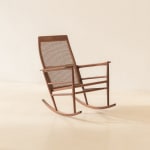-
Artworks








Joaquim Tenreiro
Rocking Chair, c. 1947| Original condition |
Rosewood, CaneA 94 cm x W 75 cm x D 97 cm
A 37 in. x W 29.52 in. x D 38.19 in.BO.JOT.001-001Further images
-
(View a larger image of thumbnail 1
)

-
(View a larger image of thumbnail 2
)

-
(View a larger image of thumbnail 3
)

-
(View a larger image of thumbnail 4
)

-
(View a larger image of thumbnail 5
)

-
(View a larger image of thumbnail 6
)

-
(View a larger image of thumbnail 7
)

-
(View a larger image of thumbnail 8
)

This rocking chair was one of the first pieces produced by Joaquim Tenreiro (1906-1992) when his Langenbach & Tenreiro store opened in 1947. Joaquim Tenreiro did not invent the rocking...This rocking chair was one of the first pieces produced by Joaquim Tenreiro (1906-1992) when his Langenbach & Tenreiro store opened in 1947.
Joaquim Tenreiro did not invent the rocking chairs – they were part of the interior spaces in most Brazilian colonial houses. Far beyond a designer and artist, Tenreiro was an intellectual and thinker of the Brazilian culture.
What Tenreiro did was to design and produce a piece of furniture where the lightness could manifest itself through a graceful and functional form.
This artesian piece, made of solid rosewood and caned seat and backrest, is one of the most significant productions – an appropriate response to Brazil's hot climate. It is part of the collection of a traditional family in São Paulo and the original condition.
"When I was making furniture, the plaited cane had almost disappeared in Brazil; nobody used it. I retrieved cane from the colonial tradition. Cane originally came from India and had become a tradition in Brazil. Brazil used a cane for years. It served the purpose of the climate, mainly because of the heat in Rio de Janeiro and even in Sao Paulo. Cane was a necessary element in modern furniture."
Joaquim Tenreiro, 1985.
1of 3 -
(View a larger image of thumbnail 1
)







